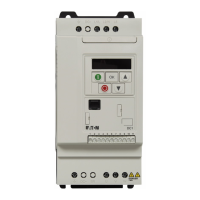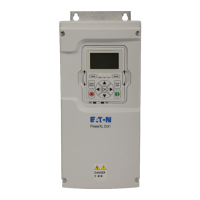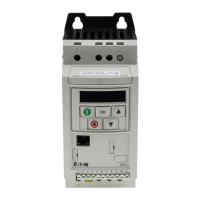6 Drives control
6.4 Braking
116 DC1 variable frequency drive 12/13 MN04020003Z-EN www.eaton.com
6.4.2 Regenerative braking
If the rotor of an asynchronous motor is driven oversynchronously in the
operating direction of the rotating field, it generates electric power via its
stator windings. The motor then becomes a generator. In the variable
frequency drive, this generative energy causes an increase in the DC link
voltage. Oversynchronous speeds occur, for example, when the output
frequency in variable frequency drive operation is reduced with short deceler-
ation times, the connected machine has a large flywheel mass or when the
flowing medium in pumps and fans works against the speed reduction.
The increase in the DC link voltage is monitored by the DC1 variable
frequency drive and always enables a braking torque of approx. 30% of the
rated motor torque. A higher braking torque can be achieved with a more
powerful variable frequency drive. A braking chopper is integrated into DC1
variable frequency drives with a size of FS2 or bigger. When used in conjunc-
tion with an external high-capacity resistor, this brake chopper makes it
possible to achieve braking torques of up to 100% of the rated motor torque.
The braking chopper will be activated at a DC link voltage of 390 V or higher
in DC1-x2… part nos. and 780 V or higher in DC1-34… part nos. If the voltage
falls down to 378 V in DC1-x2… part nos. / 756 V in DC1-34… part nos., the
braking chopper will be deactivated. The external braking resistance is
connected via terminals DC+ and BR.
Figure 70: Regenerative braking with external braking resistance
a Machine flywheel mass
b Inverter with brake chopper (braking transistor)
c Braking resistance (R
B
) → Energy flow (braking torque)
M
R
B
3
˜
①
②
③
ϑ

